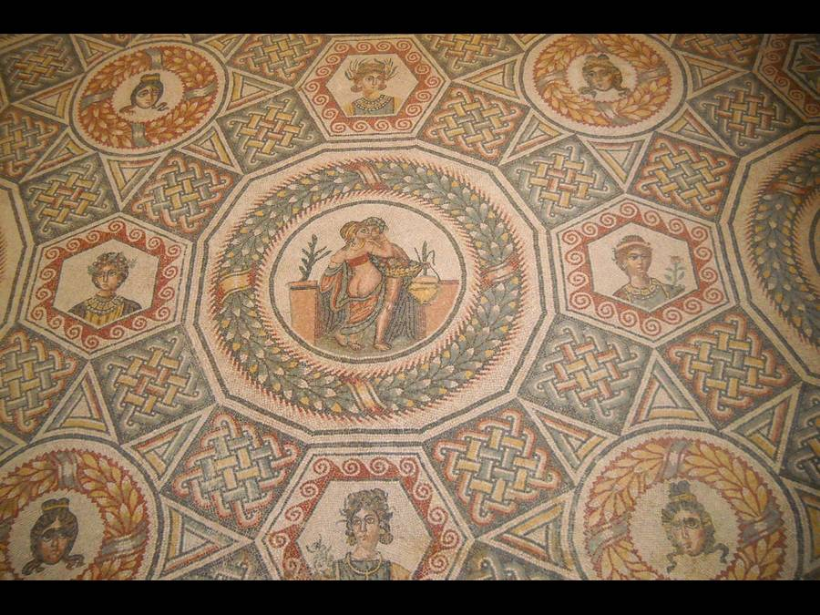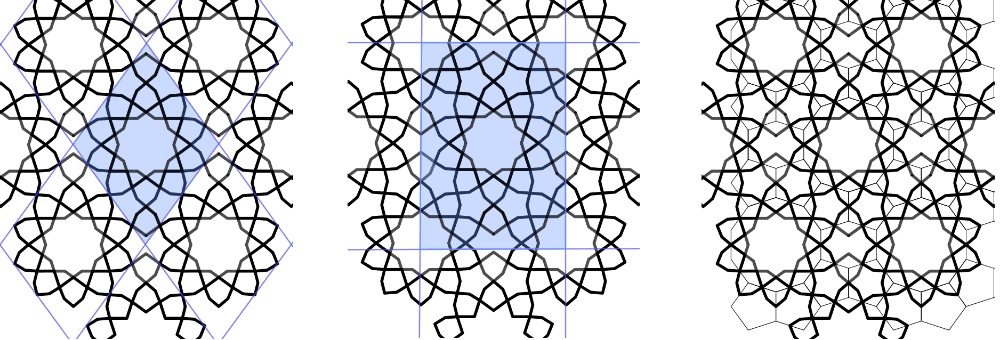Eric Broug
The book Islamic Geometric Design of Eric Broug is as well a beautiful book to look at as an easy readable book for all who’s interested in the issue. Like Jay Bonner and Carol Bier he situates the evolution of the patterns within a broader cultural context. Underlying polygonal patterns didn’t suddenly fall out of the sky in the region of Maragha around the year 1200 AC. In contrast with the suggestion of Lu and Steinhardt there wasn’t a sudden transition from ruler and compass construction to girih patterns. Broug writes the polygonal method was in use from among the first created decorative patterns and grew out quickly to the most used method. You mustn’t isolate the Islamic world from other cultures. Euclid and other mathematicians were known and Broug refers to Greek band-shaped ornamentals and Roman mosaics as in the Villa Romana del Casale on Sicily.

A grid of squares, hexagons, dodecagons and triangles serves as a frame for abstract motives and figurative representations of persons and scenes. For the Romans this grid was structural but a well visible as well. In the Islamic geometric patterns only served as an underlying frame for a visible line pattern.
working method
As other authors Eric Broug asks himself how the decorators worked. He suggests that the most obvious method to analyse a pattern isn’t necessarily how it was created. He illustrates with a classical pattern of decagons and pentagons. You can situate/create this pattern within
- method 1: a rhombic pattern with rhombic unit repeat
- method 2: a rectangular pattern with rectangular unit repeat
- method 3: a polygonal pattern of decagons and pentagons
- method 1: A rhombus is the smallest possible unit repeat to define the pattern, but not recommendable to realise. A rhombus is difficult to draw exactly. So it’s the most natural but the least practical way.
- method 2: a rectangle is the most efficient form tilings but it doesn’t offer creative opportunities. This is why it isn’t recommendable for designing.
- methode 3: The polygonal method offers most creative opportunities. The constituent polygons can produce different patterns. But drawing such a grid takes time.

Combination of method 2 and 3 in Isfahan?
Broug suggests that the polygonal method is the preferred design method. In a regular pattern a unit repeat ban be defined out of this pattern to be used during the realisation. It’s an interesting view to solve the dilemma of the pattern with 7-fold symmetry in the Friday Mosque in Isfahan (See chapter other tiles).

The pattern can be read within a polygonal pattern of two irregular hexagons. But the preserved documents describes a unit repeat. Could it be that the pattern was designed with the polygonal pattern followed by the definition of a unit repeat? This would match the conclusion of Hogendijk that the polygonal pattern was used during the design proces but not during the realisation.
Gunbad-i Kabud
The thinking track of the use of a polygonal pattern during the design process and a unit repeat during the production process, seems less probable for the wall panels of the Gunbad-i Kabud in Maragha, with a unit repeat not smaller than the whole panel. Such a unit repeat is not at all a simplifying of the production process. Very carefully Eric Broug writes it isn’t excluded that the workers had an available set of basic forms, to create the pattern as a puzzle. And so we’re back to the article of Lu and Steinhardt who raised much attention for the subject.